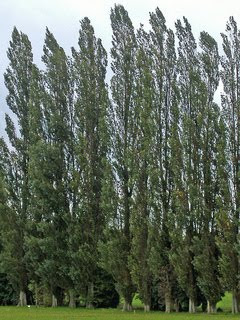Sorry for the sporadic posting of late--I'm trying to finish up my syllabi before the start of term next week. I have found time to watch two films lately: James Cameron's
Avatar and Cormac McCarthy's
The Road--both of which feature trees as main characters.
Avatar
I'm at the age now where I was completely impressed with Cameron's digital effects ( I feel like my parents describing the first time they saw
Star Wars)--but I was even more impressed with his treatment of trees in the film. If you haven't seen the film yet, the Na'vi live in a "home tree," an ancient arbor that is networked, through its roots, to the other trees on the planet, creating a sort of neural network more complicated than the human brain.
I'm not the first to notice the environmental message in this film.
Mother Nature Network recently ran a piece on the
radical conservation message in Avatar. I'm unable to find a picture of this beautiful, imaginative tree, so here's the best I can do.
Let's not forget that trees are one of the oldest species on the planet, and their evolution over millions of years have created the conditions that led to our own evolutionary track. To disrupt this complicated network of oxygen- producing beings is to complicate, and perhaps destroy, our own future in this symbiotic network on life.
I have to say, you must see this film in 3D if you see it. I often felt myself connecting with those first film viewers who (apocryphally?) hid under their chairs when they saw the train approaching from the screen for the first time. And, it's all about trees.
The Road

This film also has an underlying environmental message. The director (and author) do not say why the world has ended (including the life of all trees, birds, animals, etc.), we only know the event created the horrific conditions humanity faces to survive (which in this text, means feasting on other humans). We follow a father and son (unnamed) on their journey south along "the road." There aren't a lot of human characters (or at least characters we want to know), but there are a ton of wooded characters. Throughout the entire film, the sound of dead trees create an eerie atmosphere as they crackle, whine and collapse in the background. It is the ultimate sound of despair--and one of the only natural sounds in this dead world. It reminded me of the Tulsa ice-storm two years ago and the saddest sound I've ever heard--the sound of branches and trees moaning (it was haunting) in the dead night before cracking and collapsing.
I don't want to give the film all the credit of making the trees such a central character. The publishers chose an image for the book cover that sums up the despair and desolation of the film. We see no humans, only their traces of the "scar" carved through a dead forest.
Again, we must realize (pace creationists) that life on this planet is a complicated network of living beings that evolved over millions of years. The trees came before us, and are thus are foundational to the conditions whence we evolved. To remove the bricks from this foundation--even only a few--will weaken the entire structure. You don't have to be an environmentalist to see the chain reaction that will occur should we continue our current economic trends that exploit important tree belts.
Does anyone else have some contributions to Hollywood and trees? I'm sure there are quite a few out there. Let me know in the comments' section.
 Brain Pickings has a lovely post about Herman Hesse and trees. Go to Brainpickings to check out a longer passage from Hesse's "Bäume: Betrachtungen und Gedichte [Trees: Reflections and Poems] (public library)":
Brain Pickings has a lovely post about Herman Hesse and trees. Go to Brainpickings to check out a longer passage from Hesse's "Bäume: Betrachtungen und Gedichte [Trees: Reflections and Poems] (public library)": 










